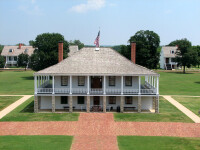Mark Garland Review of Fort Scott National Historic S...
In 1842, Fort Scott was named after Winfield Scott...
In 1842, Fort Scott was named after Winfield Scott, was established on the American frontier on the military road in eastern Kansas between Fort Leavenworth and Fort Gibson. It was established to provide protection to the rapidly increasing number of settlers, who were migrating from the Eastern United States. Fort Scott became one of a chain of forts intended to protect the new settlers from the Plains Indians, as well as to protect the Indians from the settlers' encroachment.
The United States government intention to reserve permanent Indian lands west of the Missouri River gave way to the competition of settlers continuing to encroach on the Indian settlements. Fort Scott's most active days were between 1842 and 1853, although it was also used during the Civil War.
With the Act of August 31, 1965, the National Park Service gave the city government of Fort Scott, Kansas the necessary funds and technical knowledge to restore the fort.
On October 19, 1978, Fort Scott became a National Historic Site under the supervision of the National Park Service, encompassing 17 acres (69,000 m2). Today the fort is open throughout the year, save for Thanksgiving, Christmas, and New Years Day. Visitation has declined in recent years. In 2005 visitation was 25,528; in 2007 it was 22,314.
Surviving structures include four officers' barracks, one dragoon's barracks, two infantry barracks, a hospital, guardhouse, dragoon stables, ordnance and post headquarters, quartermaster stables, bake shop, flagpole, and magazine. Another feature of the park is 5 acres (2.0 ha) of tallgrass prairie restored as part of an ecology-restoration project

Comments: